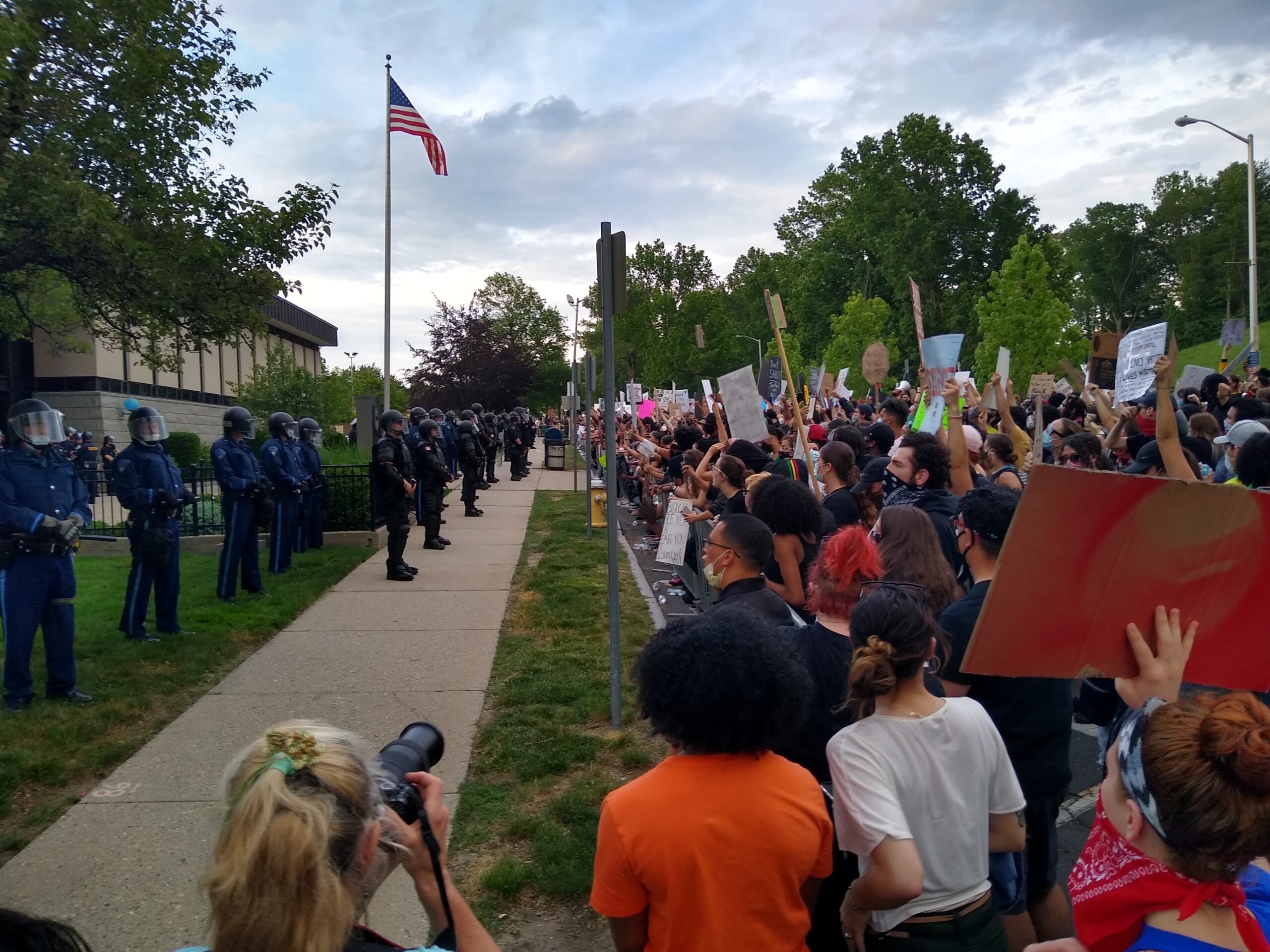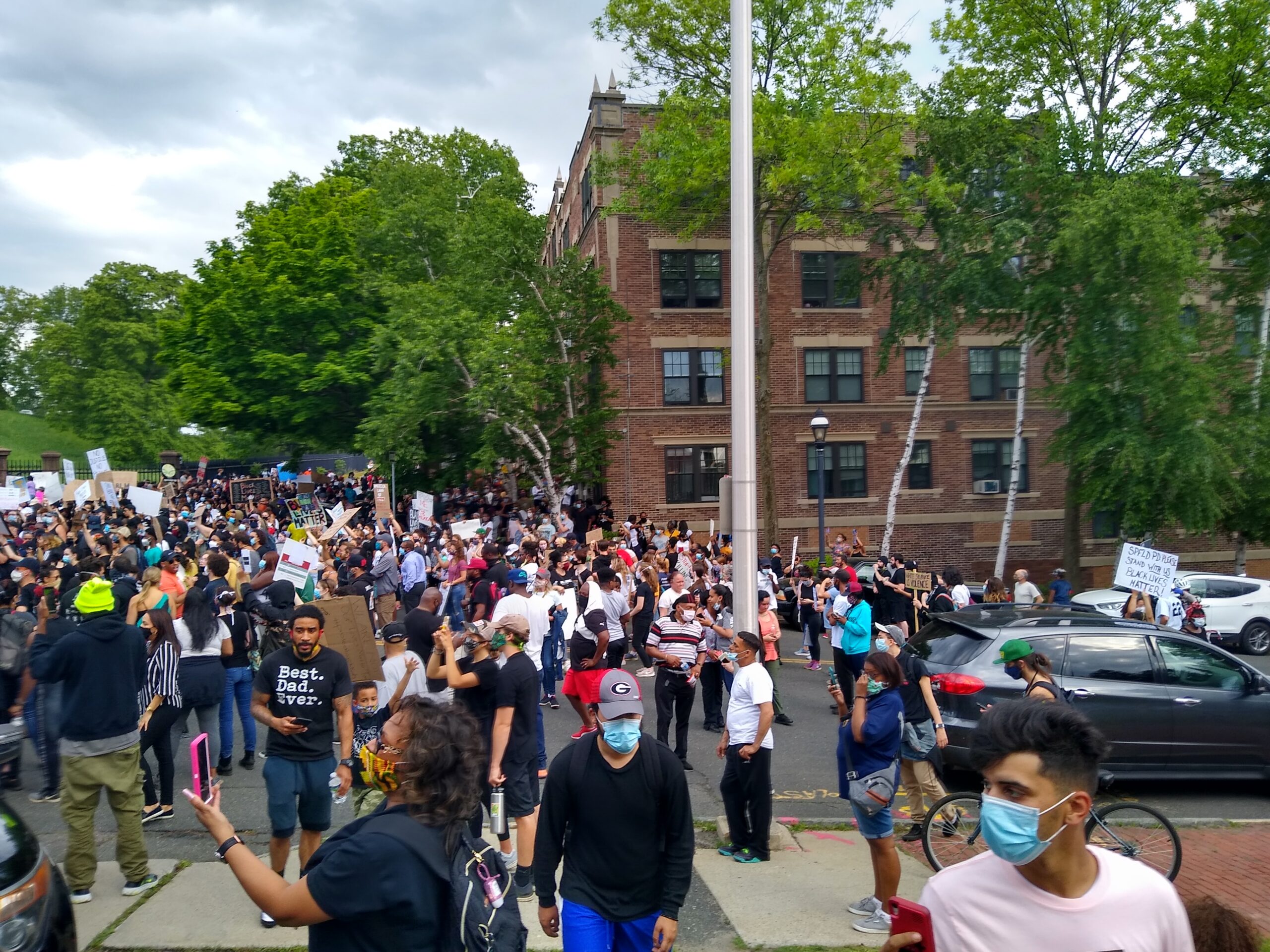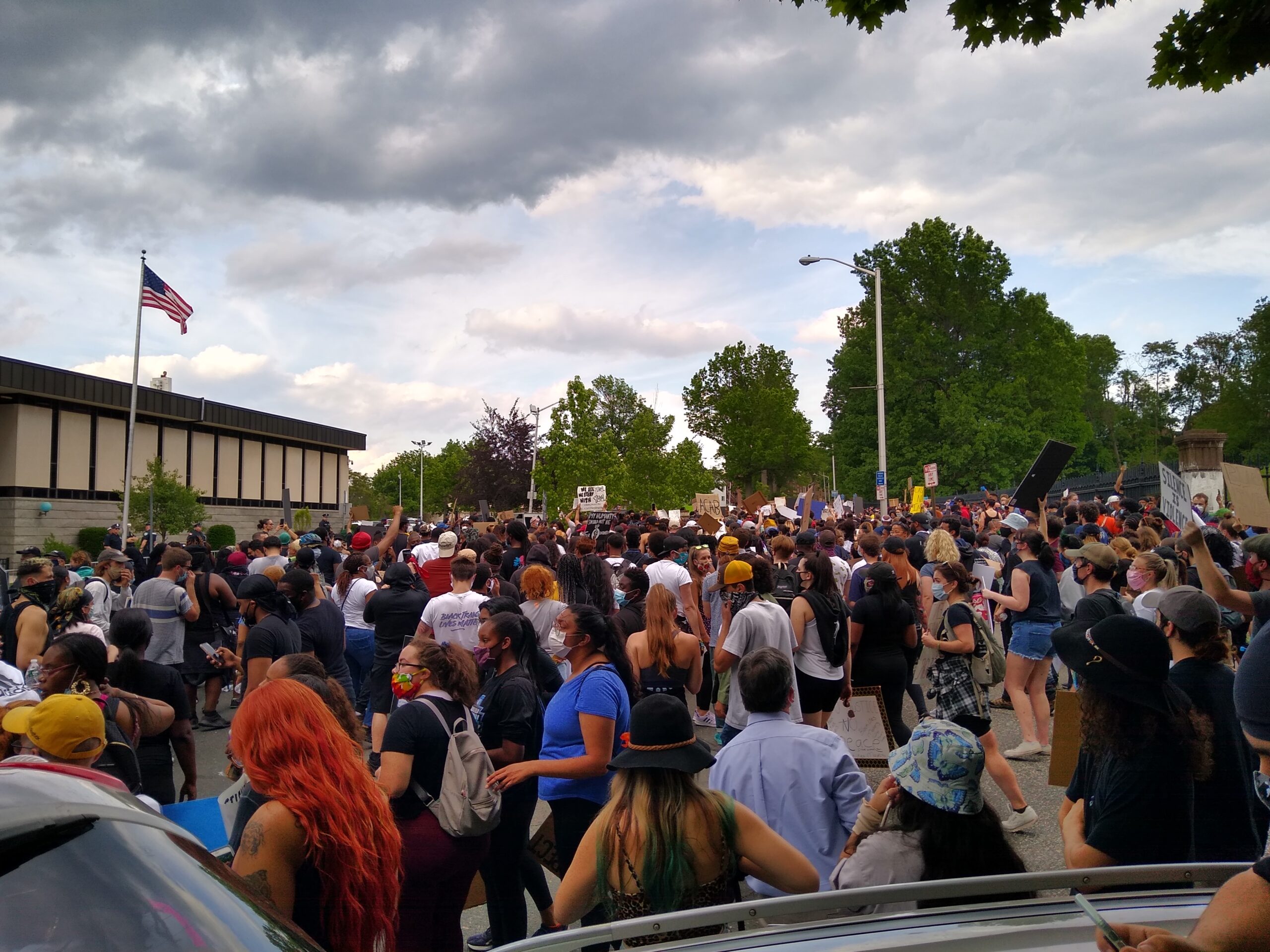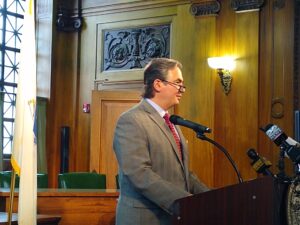Analysis: Springfield, at Its Own Complex Moment, Protests Floyd Killing…
SPRINGFIELD—A crowd of thousands wedged themselves into relatively narrow Pearl Street between Police Headquarters and the old armory fence that now hems in Springfield Technical Community College. They were there to protest police brutality and demand reforms to end the systemic racism that contributed to the killing of George Floyd ten days ago at the hand of police.
Despite some tense moments when the crowd booed after local and state police appeared in riot gear, the event was peaceful. Officials here, as elsewhere, have taken pains to empathize with protesters and condemn Floyd’s murder. Police misconduct is hardly foreign to Springfield. Still, the national wave of protests carries an odd local context: a police department long-riven by politics inside and out that has frustrated solutions both the street and the patrolmen might want.
Ultimately, this protest was not about Springfield’s ills specifically, but rather a wider architecture of racism that contributes to killings like Floyd’s, who was black, and premature deaths of nonwhite citizens nationwide. However, given the city’s own complex history, it is impossible not to consider its juxtaposition relative to the national conversation.
Marchers, who overwhelmingly wore masks, had started at Central High School and walked to the police station on the edge of downtown. It was the second such demonstration at Pearl Street, thought organizers observed that it seemed somewhat cooler than the one that occurred last week.
Overall, it may be one of the largest demonstrations the city has seen in years. Only the Springfield March for Our Lives in 2018 comes remotely close.
Politicians including City Councilors Victor Davila, Adam Gomez and Jesse Lederman and State Senator Eric Lesser were among those who made it to Pearl Street. At the end of the march, organizers were ready with water bottles—unfrozen—and snacks for those that had made the long journey.
Still, state and local police as well as the National Guard were on hand. Cops cars were placed on surrounding blocks. Fire equipment was positioned in downtown alleys, ostensibly to battle any fires that started. A Pioneer Valley Transit Authority bus lurked on a side street, perhaps to transport potential arrestees. Cops had zip-tie cuffs hanging from their belts.
Protests have rocked the nation in the week after Floyd’s death in Minneapolis. An onlooker captured everything. A Minneapolis Police Officer is kneeing on Floyd’s neck for nearly ten minutes. Dueling autopsy reports disagree about the exact mechanism of death, but agree that Floyd’s demise was homicide. The city canned the officer, Derek Chauvin and three of his colleagues. Prosecutors charged Chauvin with murder. The other cops were charged as accessories Wednesday, following the Minnesota Attorney General’s takeover of the case.
Floyd’s death was particularly brutal, clearly bereft of any mistake or panic that cloud other killings police have perpetrated.
Springfield has not seen anything quite that bad since the Jeffrey Asher beating of Melvin Jones, III. But the city has spent millions on civil rights lawsuits related to police actions.
An even darker racist history of still haunts Pearl Street, like the ham given to an officer cleared of murdering a black civilian.
Today, the department remains the subject of multiple investigations, some of which will proceed to trial once courthouses reopen full-time. The COVID-19 outbreak has sidelined a few officers and generally added another complexity to the job.
Reform, leadership and accountability remain in some limbo. Mayor Domenic Sarno has refused to acknowledge the restructuring of leadership the City Council ordered over his veto three years ago.
At the center of that is a police commission to manage. If revived, it would manage the department and, most critically, mete out discipline. The change has historically had the support of the patrolmen’s union because it would provide an outlet for internal complaints in public, buffering internal retaliation.
The city’s C3 program has mitigated some of the divide between police and civilian, but Sarno’s posture on the commission and Police Commissioner Cheryl Clapprood’s reinstatement of five cops on trial for frustrating an investigation into an assault other cops perpetrated has complicated things.
That said, city officials including Sarno and Clapprood have scrambled to get ahead of unrest here around Floyd’s death. Both condemned it and joined a large prayer vigil held Tuesday outside City Hall.

Commissioner Cheryl Clapprood (via Springfield Police)
Officials have been emphasizing de-escalation training for years. For example, while running for reelection in 2017, Thomas Ashe—now Sanor’s chief of staff—plugged the retraining. Clapprood also discussed the training on Monday during a press conference that was otherwise about COVID-19.
Clapprood described the training which evolved from a “verbal judo” to avoid physical confrontations before they begin.
“It’s to learn how to talk to people, learn how your stance, your tone of voice affects the response you’re getting,” she said Monday “It deals with relating to people and giving people a chance to vent to to you before action is taken.”
Protests have turned ugly across the country. Some instigation began with police and others with rabble-rousers among the protests. Looters, most of which were unrelated to the protests, have struck businesses while attention was on demonstrations.
Donald Trump has inflamed things further with incendiary tweets and the clearing of Lafayette Park near the White House to pose with a bible in front of a church.
City and state officials here had prepared for a bad turn, too. Before the march reached Pearl Street, officers in regular uniform lined the side of Pearl Street where the station lies. More joined shortly before protesters arrived. A drone and a helicopter held vigil from above and National Guard vehicles appeared from time to time. In the station garage were more officers. A cluster of state troopers were visible from the Worthington Street side of the station.
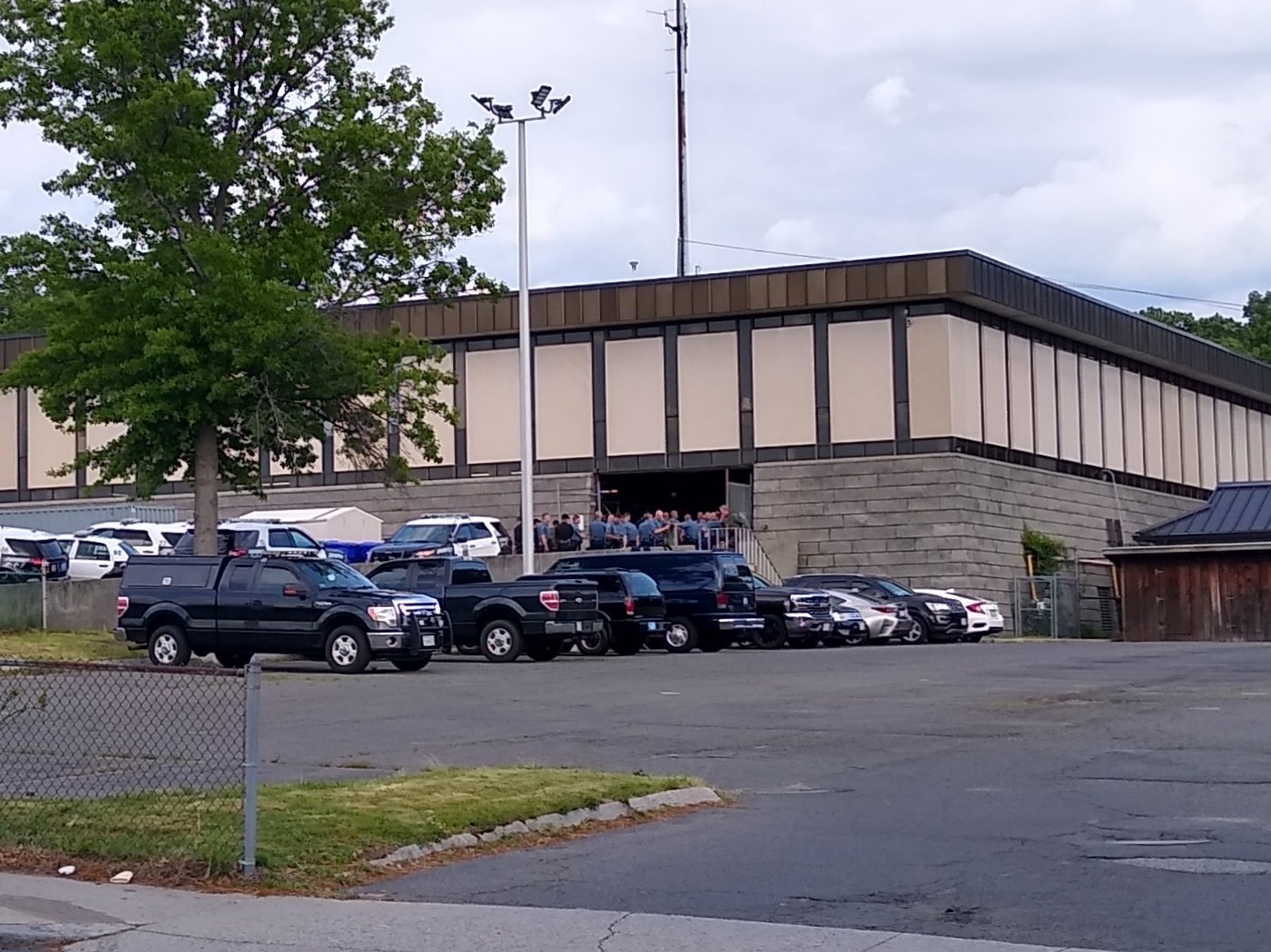
State police visible on the Springfield Police Station rear garage entrance that faces Worthington Street. (WMP&I)
It was not until marchers got there later that police in riot gear manifested. Those in riot gear returned to the lobby only to reappear, joined by Staties also in riot gear. The crowd, reasonably perturbed by the escalation, cheered at their retreat and then booed loudly at their return. Still, for some time, the regular uniformed officers held the line before stepping back so the armored cops could take their place.
Despite the ebb and flow of tension, protesters tangled with each other more than police and demonstrators ever did. A couple of protesters bickered with each other over whether some people were agitating for trouble.
Aside from the boos, protesters only seemed to express disappointment at police when none took a knee when asked. In fact, most police, whether in riot gear or not, expressed little visible response to protesters generally.
Before the march arrived, a woman who announced herself as Hazel tried to stir up the assembling crowd—unsuccessfully—hurling invective about police misconduct at the officers, eliciting no response from them. A few marchers complained on social media that the cops were almost to casual chatting and laughing amongst themselves.
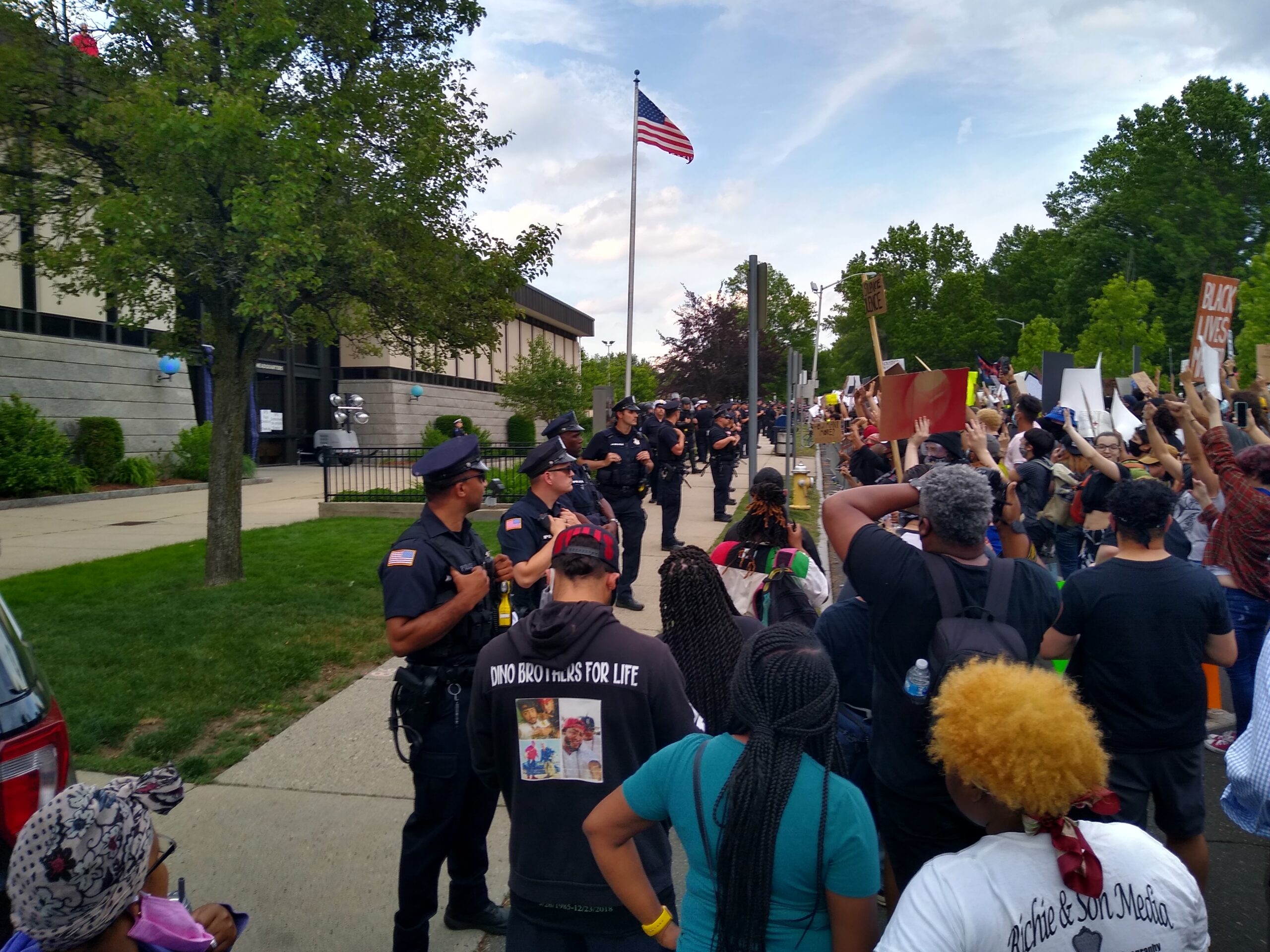
Before police in riot gear took over (some are visible in the background), it was mostly uniformed cops who lined the sidewalk in front of Pearl Street. Many spoke casually with protesters. (WMP&I)
Yet, many protesters enjoyed casual conversation with officers, too. One shrugged off the complaints a few protesters rattled off as part of the job. Past the fallen officer memorial, a sergeant and a lieutenant in regular uniforms stepped toward the barricades to speak with protesters. Another officer took an empty water bottle from a protester to have it thrown out rather than throw as a projectile.
As the sun set, the protest began to thin. People took off for their cars or even for the long walk back to Central High. Flood lights activated to keep the intersection of Pearl and Byers street lit. By about eight, the thousands had dwindled to hundreds, clustered close to the barricades, police still standing stoically.
Pearl Street had closed to traffic at Spring Street earlier. Near that end of the protest line by the garage entrance, another cop handed a protester a bottle of water. A lieutenant showed up later and asked if anybody else needed water.
He didn’t want any protesters passing out.
